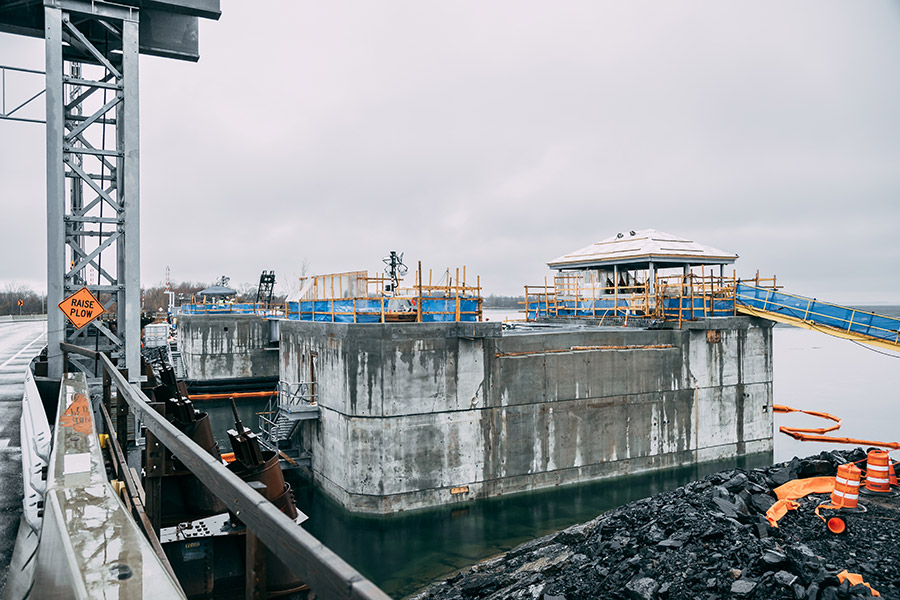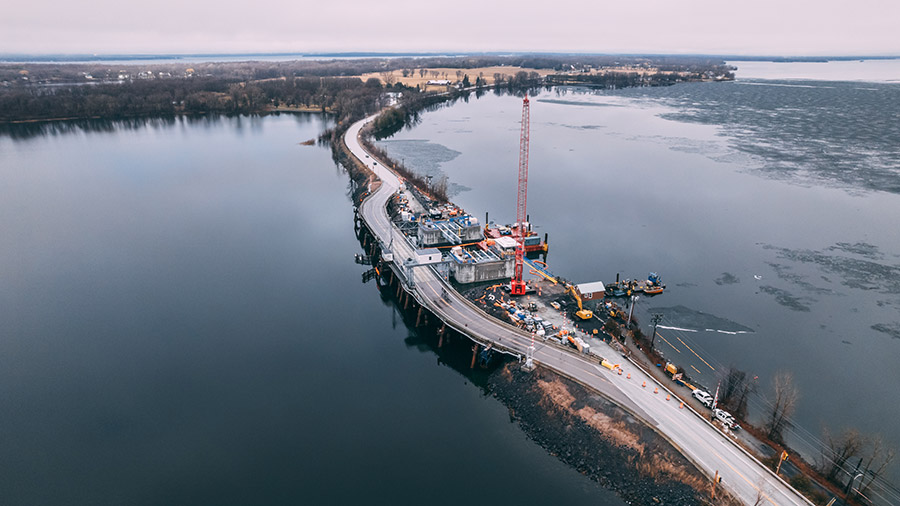With up to 80 workers—hailing from 14 states—working simultaneously on a constrained site, the project team for Vermont’s $74 million North Hero Grand Isle Drawbridge on Lake Champlain bonded with each other and the community while navigating unexpected delays, extreme winter conditions and boating season.
After experiencing more than a year in delays due to COVID-19 and contaminated soil, the project team is scheduled to finish the project on time in July thanks to a contract extension, but also because they didn’t let hardships such as minus 42-degree temperatures stop them from working. In fact, enduring these shared hardships while rebuilding the state’s only vehicular moveable bridge only brought the team and the town closer together. “We really became a part of that community over the past five years,” says Mack Susi, project manager at Cianbro, the project’s general contractor.
Cianbro demolished the old moveable bridge for the construction of the new bridge within its cofferdam. Once the structures were demolished, the team dealt with the remediation of the contaminated soils within the old bridge footprint.
Courtesy of Cianbro
Spanning 260 ft, including two 50-ft approach spans and two 80-ft leafs, the new bridge serving as the main road stretching through the islands from Colchester to Alburgh will have a 100-year design life. The 70-year-old drawbridge carrying U.S. Rt. 2 between North Hero and Grand Isle was nearing the end of its service life when the project began in 2018.
The bridge had its final inspection in June and crews recently completed final paving, line striping and guardrail work. Small change orders remain to be completed, Susi says.

Cianbro concrete crews work on forming the watertight concrete bascule piers with EFCO formwork.
Courtesy of Cianbro
Strong Delivery
Closing the existing bridge to construct the new one would have been “detrimental” to public emergency services and a bridge detour would have been 75 miles, says Todd Sumner of Hoyle Tanner, who is continuing to serve as the project's project manager for the Vermont Agency of Transportation even after officially retiring from the agency in 2021.
The design team determined that opening a temporary drawbridge to traffic was the better alternative. It was built in 2018, completed in May 2019 with traffic slipping onto it to allow for demo work to begin at the end of May, Sumner says.
The project was delivered using the two-phase Construction Manager/General Contractor method, which had design firm HDR, VTrans and Cianbro working collaboratively on the design, says Tom French, HDR senior project manager.
The bridge was designed to improve access to all locations of the moveable bridge for bridge operators, Susi says. It also prevents the superstructure (bascule span heel girders) from dipping into the lake each time the bridge opens and improves access for routine inspections and maintenance, French wrote in an overview of the design.
Phil Harrington, resident engineer for VTrans, adds the replacement bridge is “safer for bicyclists and the operator.” The new hydraulic system which replaces the mechanical one also provides redundancy with fewer components to inspect.

Cianbro crews work on the future control house and within the concrete Piers, installing utilities for bridge operation throughout the late winter of 2022.
Courtesy of Cianbro
Time After Time
The project reached substantial completion in May even though work stopped for a year while contaminated soil was mitigated.
“Essentially we were given another year on the contract,” by VTrans, making up for the delay and allowing the project to finish on schedule with the bridge opening to traffic in November 2022, Susi says.
But the contract extension following the discovery of lead and polychlorinated biphenyl (PCBs) contaminated soil in 2018 didn't account for the 11-week Covid shut down. The team still needed to work double shifts to make up lost time.
Looking back, Susi says dealing with the contaminated soil “was a daunting task,” that was a “large piece” of the time and cost extension, which added $14 million to the original $60 million project cost.
Harrington, VTrans resident engineer, says soils samples of the entire project area revealed broader contamination than anticipated. A soil management plan was developed by design firm VHB with input from VTrans and the Vermont Dept. of Environmental Conservation. The SMP allowed for reuse of contaminated soils on the project assuming they were “capped with clean material,” Harrington says. Most of the soil needed to be disposed of by landfilling with hauling and tipping fees alone exceeding $1 million.

Cianbro steel crews work on installing structural steel toe girders for the moveable bridge.
Courtesy of Cianbro
Access on the job site was another major job constraint with only one way in and out on each side of the bridge, Susi says. “All of our concrete placements were planned well in advance, including the large tremi placements for the foundations, which took nearly 26 hours on the job site.
With lots of steel and concrete used for the project, “this erector set wasn’t always lining up the way you wanted it,” Sumner says. Cianbro worked internally with its fabricators G&G Steel and Cianbro Fab and Coating utilizing Building Information Models (BIM) for all its steel connections, Susi says. That assisted the team with putting about 16,000 bolts on the bridge to make every connection work.
Accommodating boating season was another challenge since the lake requires the drawbridge be open from May 15 to Oct. 15. Given the project’s delays, crews could not afford to stop constructing during the busy boating season. Building one leaf at a time allowed both boat passage and construction to continue. “While we were working one leaf, the other one had to be in the air so that boaters could go underneath in one-way traffic…a unique way to put a bridge together,” Susi says. “One leaf would be locked in the upright position while we were working on the steel and the concrete deck on the other side.”
The team originally planned to construct both leaves simultaneously. With final approval from the Coast Guard in communication with the local marinas, the team was able to proceed “without any overall delay in the final project,” he says.

Cianbro subcontractors work on installing the final bridge rail on the lowered leaf while the other bascule leaf is held in the upright position.
Courtesy of Cianbro
Wind Tunnel
Working in extreme cold on the lake required teamwork to stay safe. Susi recalls the first night shift in mid-January 2022 when the team was preparing to remove pile platforms on the side of the cofferdams. This involved use of “cutting torches for the steel platform and pipe pile extraction utilizing a vibratory hammer,” Susi says.
At minus seven degrees F, the team decided not to work. Unfortunately, the weather for the next day and the following week was only worse. Despite the dire prediction, everyone chose to work rather than take time off, he says. “It got colder and colder.”
To protect themselves against high winds whipping across the lake and wind chill temps of minus 42 degrees F, the team built warming huts and avoided skin exposure to protect themselves from frostbite.
“They rotated two workers at a time, working 15 to 30 minutes, then came back inside to warm up and rest,” Susi says. “This involved a lot of teamwork and looking out for each other.”



